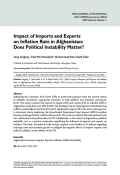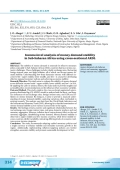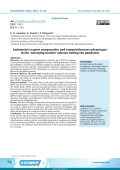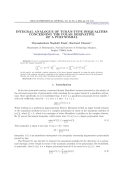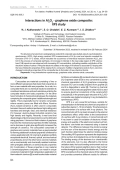About 2,200 km3 of wastewater is discharged into the environment annually: municipal (including households), industrial and agricultural (including drainage water) – at the same time, as indicated in the UN World Report on the State of Water Resources for 2023. Over the past 40 years, global water use has been increasing by about 1 % per year and is expected to grow at this rate until 2050 as a result of the combined impact of factors, such as population growth, socio-economic development and climate change consumption patterns. With increasing consumption of water resources, the volume of their pollution increases, which creates serious environmental, economic and social problems. In this regard, the preservation of water and food security through sustainable management of water resources, universal quality provision of water supply and sanitation services are global problems all over the world and require an integrated approach involving government agencies, private business, academia and public organizations. The water supply and sewerage industry has an extremely important social character, as it directly affects the health of the population and the environment. This requires the use of new effective environmentally friendly technologies for cleaning blockages and improving the mechanical characteristics of sewer pipelines, which will significantly increase their service life and reduce repair costs. The conducted studies have proved the effectiveness of using small-sized ultrasonic devices with an ultrasonic generator with a power of 0.1–10 kW, a frequency of 20–40 kHz, and a magnetostrictive transducer.
We describe introduced in the journal the rubric system. We describe the general structure of an IMRAD research publication. The IMRAD structure for a research article is described in detail.
Stabilizing the Consumer Price Index (CPI) to protect the populace from the adverse effects of inflation necessitates appropriate measures at both political and economic governance levels. This study examines the impacts of imports (IM) and exports (EX) on inflation (CPI) in Afghanistan using data from 1990 to 2023. The findings from the Autoregressive Distributed Lag (ARDL) model indicate that both IM and EX significantly impact CPI in the short and long term. A robustness check employing the Kernel-based Regularized Least Squares (KRLS) machine learning technique further validates these results. The analysis confirms that international trade has a substantial and positive effect on CPI. Additionally, in the context of Afghanistan, political instability acts as a positive moderator, amplifying the influence of imports and exports on inflation. The study concludes that the country requires a reevaluation of its policies regarding exchange rates and economic growth to mitigate the negative effects of imports, exports, and political volatility on the stability of the CPI.
Relevance. External shocks can disrupt stable industrial development and technological modernization, especially in open single-industry regions that are highly vulnerable to global market fluctuations. The dominance of a single sector results in structural inertia, making it difficult for these regions to shift their economic trajectory. This path dependence amplifies the risks posed by economic turbulence, highlighting the need for changes in the economic structure and strategic guidelines for regional industrial policies. Objective. This study aims to describe the current, strategic, and future development paths for single-industry regions amid economic turbulence. It focuses on changes in the industrial profiles of metallurgical regions in Russia, including Lipetsk, Vologda, Murmansk, Sverdlovsk, Chelyabinsk, and Krasnoyarsk. Data and methods. The research uses publicly available statistics from 2008 to 2021, grounded in regional development theory. Methodologically, the study relies on coefficient analysis, positional-dynamic analysis, and assessment of technological connections between sectors. Results. The study has detected significant differences in regional adaptation: Lipetsk and Chelyabinsk are shifting towards low-tech sectors, Sverdlovsk maintains its metallurgical focus, Vologda is balancing metallurgy and a medium-high-tech chemical industry, while Murmansk and Krasnoyarsk are transforming with a focus on low-tech mineral extraction. Promising specializations include machine engineering in Sverdlovsk and Vologda, as well as machine engineering and electrical equipment production in Lipetsk and Chelyabinsk. However, we found discrepancies between the declared strategic goals and actual priorities in Lipetsk and Chelyabinsk. Conclusions. The findings offer valuable insights for policymakers and authorities, helping to update strategies for fostering the growth of promising industrial sectors.
Relevance: The stability of money demand is essential for effective monetary policy, especially in Sub-Saharan African (SSA) countries that face various economic challenges. These challenges include volatile exchange rates, fluctuating foreign interest rates, and high inflation, all of which can disrupt money demand stability. Understanding how these dynamics interact with different income levels-upper middle, lower middle, and low-is crucial for developing effective regional monetary policies and achieving economic stability. Research Objective: This study aims to evaluate the stability of money demand across different income levels-upper middle, lower middle, and low-in SSA. By applying the cash-in-advance theory, the study seeks to provide insights and actionable policy recommendations on the influence of key economic variables. Data and Method. This study employs the cross-sectional augmented autoregressive distributed lag (CS-ARDL) model to analyze both the short- and longrun influences of real exchange rates, foreign interest rates, real GDP, and inflation on money demand. By doing so, it aims to provide a nuanced understanding of money demand stability, capturing variations often overlooked in existing research. The analysis uses data from the World Bank Indicators and the International Monetary Fund (IMF), allowing for a detailed examination of money demand stability across various income levels in the region. Results. The findings reveal a positive and significant relationship between the real exchange rate, foreign interest rates, real gross domestic product, and real monetary aggregates. However, inflation has a contractionary effect on the real monetary aggregate, destabilizing money demand. Money demand stability is observed in upper-middle and low-income countries, while lower-middle-income countries exhibit variability, indicating differing levels of economic resilience across income categories. Conclusion. The study recommends adopting unified monetary policies and a single currency to enhance stability and stimulate economic growth in the region. Additionally, implementing inflation-targeting policies can further strengthen economic stability and promote sustainable development in SSA.
Relevance. The unprecedented disruptions caused by the COVID-19 pandemic had a profound impact on the global economy, including Indonesia. Despite the challenges, Indonesia successfully managed to navigate and recover its international economic activities. Analyzing how Indonesia navigated its export advantages during the COVID-19 pandemic is crucial for understanding its resilience in the global economy. Research objective. The study aims to analyze the comparative and competitiveness of Indonesian export products, particularly the food processing industry, under the scheme of emerging markets and developing economies during the COVID-19 pandemic. Data and methods. This study relies on the data from Badan Pusat Statistik (BPS) and the Indonesian Ministry of Trade, along with world export data from the World Bank, OECD, and the International Trade Center, to examine the food processing industry during the 2021-2022 pandemic. Using the Revealed Comparative Advantage (RCA) model, it classifies comparative products for potential exports and diversification guidance. The Export Product Dynamics (EPD) model measures competitive advantage and serves as an early warning indicator, providing a comprehensive trade analysis for identifying growth opportunities and mitigating risks. Results. The RCA findings indicate that Indonesian processed food products for emerging market countries exhibit strong comparatives, supported by factors such as selling prices, production capacity, innovative technology, and trade tariff policies. This is reinforced by the results of the EPD analysis, which shows the dominance or rising star status of these products. Conclusions. The dominance of processed Indonesian food products points to the need for the government to uphold and expand exports beyond emerging market countries. Recommended measures include initiating revitalization, transformation, market analysis, and evaluating products categorized as falling stars or experiencing failures, missed opportunities, and retreats. Additionally, a focus on the upstream-downstream sectors of the food processing industry is crucial.
Relevance. As interregional competition intensifies, state support for innovation in regional economies becomes increasingly important. To improve the effectiveness of such support, it is necessary to gain a better understanding of the link between innovation and economic development. Research Objective. The study aims to assess the impact of innovation activity on regional economic growth, focusing on the case of a large industrial region in Russia. Data and Methods. The analysis uses socio-economic data for Sverdlovsk region from 2000 to 2023 and applies an autoregressive distributed lag (ARDL) model to assess the relationship between innovation and economic performance. The study introduces an Innovation Activity Index, which incorporates several key components, such as the number of research personnel, internal R&D expenditures, and other relevant indicators, for a more comprehensive evaluation. Results. The study traces the region’s innovation activity, revealing a general upward trend. However, while innovation clearly has a positively influence on economic growth in the short term, its effects over medium- and long-term periods are less obvious, likely due to structural factors in the regional economy. Conclusion. The study proposes recommendations to enhance regional innovation support within the «smart specialization» framework, including backing innovation projects, developing a sustainable innovation ecosystem, and investing in human capital.
In this article, we establish a refined extension of the above integral inequality by using the polar derivative instead of the ordinary derivative consisting of the leading coefficient and the constant term of the polynomial. Besides, our result also yields other intriguing inequalities as special cases.
For the class of bounded in l2-norm interpolated data, we consider a problem of interpolation on a finite interval [a, b] ⊂ ℝ with minimal value of the L2-norm of a differential operator applied to interpolants. Interpolation is performed at knots of an arbitrary N-point mesh ΔN: a ≤ x1 < x2 < < xN ≤ b. The extremal function is the interpolating natural -spline for an arbitrary fixed set of interpolated data. For some differential operators with constant real coefficients, it is proved that on the class of bounded in l2-norm interpolated data, the minimal value of the L2-norm of the differential operator on the interpolants is represented through the largest eigenvalue of the matrix of a certain quadratic form.
The main aim of this paper is to present and explore some of properties of the concept of -statistical convergence in measure of complex uncertain sequences. Furthermore, we introduce the concept of -statistical Cauchy sequence in measure and study the relationships between different types of convergencies. We observe that, in complex uncertain space, every -statistically convergent sequence in measure is -statistically Cauchy sequence in measure, but the converse is not necessarily true.
Речь в статье идет о проблеме политической интерпретации сочинений Драконция, римского поэта из Карфагена конца V в. Тезис о социально-политической подоплеке его поэм получает все большее распространение в последние годы. Основания для этого дают многочисленные отсылки к современным ему событиям: становлению вандальского королевства в Северной Африке, прежде римской, и сопутствовавшему конфликту старой и новой элит. Тем не менее позиция автора по отношению к этому конфликту, оценка им его сторон пока остается предметом дискуссий. Ключ к их разрешению во многом кроется в правильном понимании авторских симпатий и антипатий по отношению к собственным персонажам, заимствованным из традиционных античных мифологических сюжетов, чье поведение оказывается проекцией на современные Драконцию события. Один из таких персонажей — Геркулес. Он возникает сразу в двух поэмах, Romulea 2 и 4. Его образ в них ломает многие стереотипные представления о героической и трагической природе этого персонажа; в статье предпринимается попытка дать этому объяснение. В своей работе я стремлюсь доказать, что этот герой представлен как амбивалентная модель. С одной стороны — как воплощение римской стороны в римско-вандальском противостоянии — для римской аудитории, а с другой — как образец правильного поведения в конфликте в принципе. В этом смысле связанный с ним дидактический пафос мог быть обращен и к вандалам.
The structure of an aluminum oxide/graphene oxide (GO) composite was studied using X-ray photoelectron spectroscopy (XPS). High-energy resolved XPS measurements of Al 2p-core level spectra revealed the formation of Al-O-C bonds, which indicated the occurrence of interfacial reactions between Al2O3 and GO in the process of composite synthesis. An increase in intensity in the near-edge region of XPS valence band (VB) spectrum was observed with increasing GO concentration, indicating possible contribution of the electronic states of carbon. Filling the electronic states on the edge of VB allows to associate GO doping with the loss of dielectric properties of the original Al2O3 compound. Addition of graphene oxide to Al2O3 ceramics changed conductive properties of the composite due to formation of new chemical bonds.


